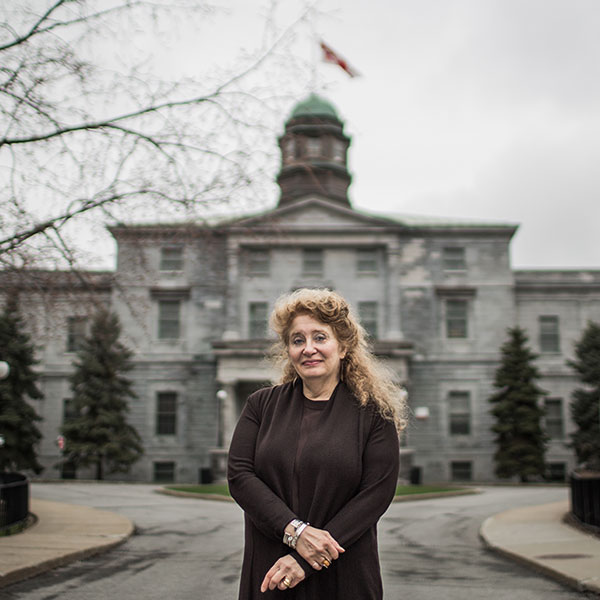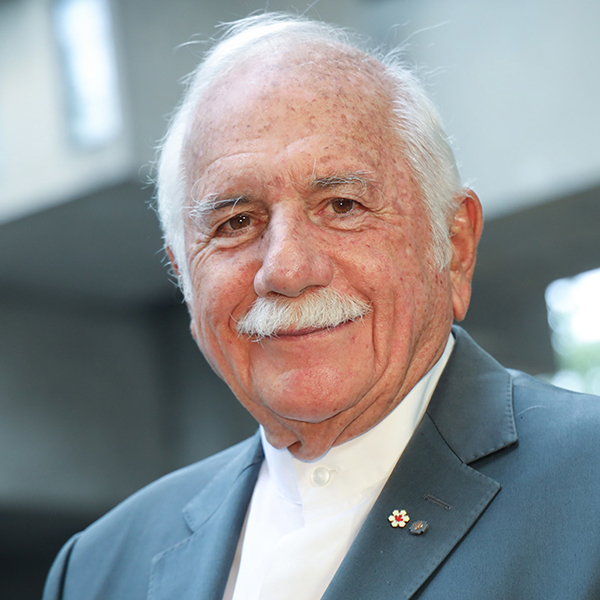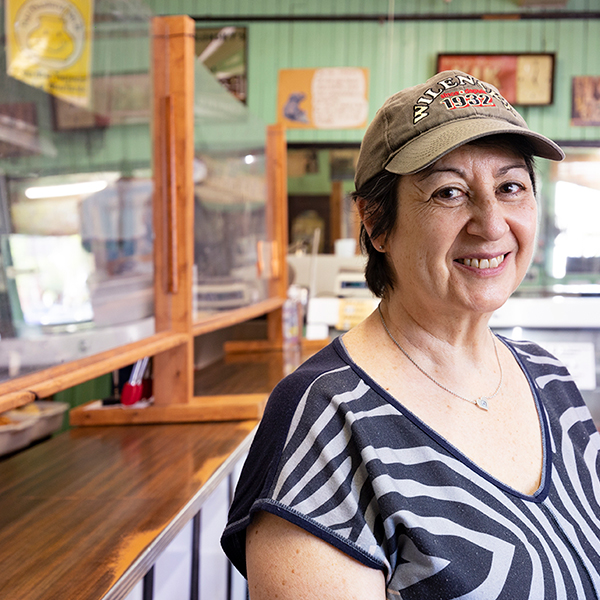Julia Gersovitz, BSc(Arch)’74, BArch’75, has never been one to let the bricks fall where they may.
An adjunct professor at McGill’s School of Architecture, Gersovitz is one of Canada’s foremost heritage architects and is recognized as a pioneer and top authority on the preservation of historic buildings.
Marquee projects she has played a key role in include the innovative Maison Alcan in downtown Montreal, major renovation work at the Centre Block and East and West Pavilions on Parliament Hill, and the recent revitalization of Toronto’s Union Station.
In 2015, Gersovitz won Canada’s top prize for heritage conservation, the Gabrielle Léger Medal for Lifetime Achievement in Conservation. The year before, she received the Harley J. McKee Award from the Association for Preservation Technology International for her contributions to architectural preservation.
Her opinion carries considerable weight in official circles. At the municipal level, she has served on advisory committees devoted to issues like planning, preservation and urban design. As a member of the Commission des biens culturels, she helped provide counsel to Quebec’s minister of cultural affairs on heritage matters. At the national level, she has served as a special advisor to the National Capital Commission for the governor-general’s residence.
She is “the grande dame of heritage architecture,” says Martin Bressani, BSc(Arch)’79, BArch’80, the director of McGill’s School of Architecture. “Julia is a public figure, an advocate, not just an architect doing work in conservation. She has established herself as the premier conservation architect in Canada” and “has an intense love of the historic fabric of Canadian cities.”
An historical perspective
Over the course of her long career, Gersovitz has seen a lot of progress made in the general societal awareness of the value of heritage conservation. But she warns that much work remains to be done as celebrations mark the 150th and 375th anniversaries of Canada and Montreal, respectively.
“I don’t think that [Montrealers] should be so self-congratulatory, in that we have not made the strides that we should have in 20 years to keep us at the forefront of conservation, either in theory or in practice,” she says.
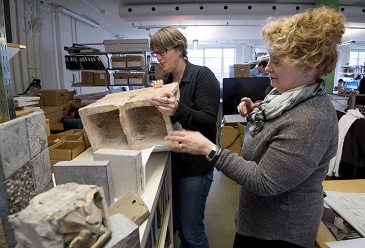
“There has been great work and there has been a lot of awakening on a neighbourhood basis, so that people are celebrating the texture of their quartier, but there is still so much to do. You can drive around the Montreal island and see so much loss that you cry.”
It doesn’t take her long to come up with examples.
“You can argue [that Victorian architecture] is still under threat. Look at what happened with the Mount Stephen Club. We won’t go into that whole story. It’s too gruesome,” she says, clearly chagrined by the controversy over the structural problems the supposedly protected building – the former home of rail baron and financier Lord Mount Stephen, built between 1880 and 1883 – recently experienced during its problem-plagued transformation into an 80-room boutique hotel.
Gentrification, in particular, is a double-edged sword, she believes.
“When people moved into Griffintown [Montreal’s old Irish district, south of the downtown core], did they conserve that area? No, they destroyed it. The gentrification of Griffintown has come with a gigantic eraser, in which they erased the entire past of Griffintown and replaced it with another whole type of architecture.”
One piece of good news that relates to her own past was the recent decision by the province to designate the Maison Alcan complex as a protected heritage site.
“I’m satisfied that they have protected the buildings,” says Gersovitz, but the heritage status does not absolutely rule out future changes. Although earlier plans by Cirque du Soleil founder and Maison Alcan owner Guy Laliberté to demolish parts of the complex and erect a 30-storey office tower are now forbidden, Laliberté retains the option to make some modifications.
Maison Alcan marked Gersovitz’s first major success as a young architect. Collaborating with a team led by Ray Affleck, BArch’47, DSc’84, the celebrated co-founder of ARCOP, Gersovitz was responsible for overseeing the integration of several old Golden Square Mile buildings – including the Berkeley Hotel – into the complex. The graceful blending of those heritage buildings with a slick aluminum-clad office structure was generally hailed as a triumph.
Before any big project can begin, Gersovitz and her team intensively research the history and evolution of the building they will be working on. “The research informs the project direction, influencing all kinds of design decisions,” she explains.
Modifications are inevitable, given the need to make concessions to modern building code standards and changes to accommodate heating, air conditioning, sprinklers, increased lighting and fire exits and elevators.
In the case of Maison Alcan, for example, gypsum board instead of plaster was used on large expanses of repaired wall, but the original decorative plaster rosettes and cornices were preserved.
Twenty-first-century technologies are used when appropriate, such as modern scanning and investigative techniques. It’s a “healthy blend of tried-and-true and innovative,” says Gersovitz. “Innovative is great for diagnostics. Repairs often, but not always, rely on old technology.
“The big challenge is again balance and quite frankly, also having the desire and the ability to find solutions that are not standard in the industry, so that the new interventions can be subtle and threaded. Sometimes there is work in ‘the spirit of,’ but if it is well conceived, well detailed and well built, it contributes to the reading of the new whole and it begins to gain value on its own.”
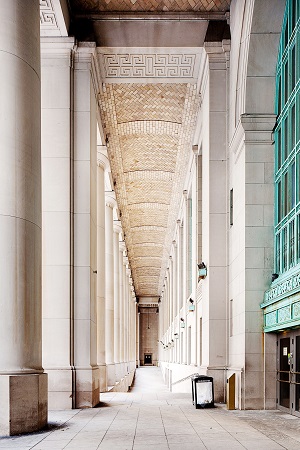
Gersovitz sometimes jokes that her genes dictated her career path – she is the daughter of an artist-printmaker (Sarah Gersovitz) and a structural engineer (Benjamin Gersovitz, BSc’40, BEng’44, MEng’48). She has been teaching courses on such subjects as conservation and architectural history at McGill since 1980 and was also an adjunct professor for the Université de Montréal master’s program in conservation for 25 years.
“Thoughtful, persistent, tenacious, nurturing and generous” is how Christina Cameron, the Canadian Research Chair on Built Heritage at the Université de Montréal’s School of Architecture, describes her.
Seated in the small, cozy library at the Montreal head office of EVOQ, the firm she co-founded with fellow architects Rosanne Moss, BSc’68, BArch’79, BSc(Arch)’79, and Alain Fournier, BSc(Arch’74), BArch’75, Gersovitz says the mix of practicing and teaching has been “terrifically nourishing.”
Teaching requires “you to be forced to stay current in your field. It provokes you and the students are asking questions and you have to look at a problem another way ‘round.”
A passion for preservation
Victorian architecture, specifically Montreal’s stock of fine old 19th-century greystone buildings, has long fascinated Gersovitz. Her master’s thesis at Columbia University in New York was about Montreal’s venerable Square Mile mansions and stately buildings and the architects who built them between 1860 and 1914.
“Emotionally, I get a tremendous charge out of late Victorian architecture,” says Gersovitz, surrounded by books on everything from plastering skills and roofing and siding techniques to architectural renderings by famous American architects; the firm’s busy offices sprawl across two airy, light-filled floors of a 1952 building in the former fur district of downtown Montreal.
On her right hand is a ring with an enormous African amber stone, an item of ornamentation she crafted herself in jewelry class, a break from work she refers to as “one of my life-savers.”
Gersovitz’s baptism by fire as a heritage activist came in the early seventies, when seemingly unaccountable developers were knocking down jewel after jewel in Montreal’s rapidly dwindling supply of historic edifices, including the Van Horne mansion on Sherbrooke Street. Gersovitz joined efforts to implement stronger conservation measures and was a founding member of the non-profit group Heritage Montréal.
Colleagues and clients say she knows how to hold her ground on issues dear to her heart, speaks bluntly when necessary, but is warm and accessible.
“On the job site or across the dining room table, Julia is invariably herself, with no airs and with her trademarked wicked sense of humour,” says former Westmount mayor Peter Trent. “I have rarely seen Julia lose her cool.
“While unflappable, she can launch a zinger so swiftly that many are not even aware of her missile hitting home,” Trent adds. “She can talk to workers on a job site or to CEOs of multinational corporations with little modulation between.”
He praises her for her “brilliant work” on restoration projects for the Westmount Public Library, Westmount City Hall and Victoria Hall.
McGill isn’t just a place where Gersovitz teaches. The University’s own extensive collection of historic buildings has profited from her expertise.
When McGill’s Lady Meredith House, built in 1897, was damaged by fire in 1990, Gersovitz worked with the University to restore the building to its Golden Square mile glory, winning a Prix Orange from Sauvons Montréal. She and EVOQ have also won awards for restoration projects involving the Arts Building and Redpath Museum.
More recently, Gersovitz and EVOQ were commissioned by the University to put together a heritage inventory of McGill buildings on both the downtown and Macdonald campuses.
All Quebec universities face challenges when it comes to funding their infrastructure needs, but Gersovitz believes McGill’s circumstances are especially daunting, given that so many of its buildings are so old.
“This University is a steward for its campus,” she says. “That campus is enjoyed by the larger Montreal community, the larger Quebec community, the larger Canadian community. This is not a gated community. We are open and porous to the whole city. And I think the University is bearing the burden of all the upkeep of these buildings.”
Her favourite McGill building, hands down, is the 19th-century Redpath Museum. “It’s terrifically inventive,” she says. She’s also a fan of the sixties-era, raw concrete, Brutalist-style McLennan Library, a building that draws harsh critiques from some students and faculty (“prison-like” is often used as a descriptor).
“It’s quite a beautifully detailed building on the inside,” she insists.
When it comes to older buildings, particularly in Montreal, no one has an eye for detail quite like Julia Gersovitz. The library’s detractors might want to take another look.
